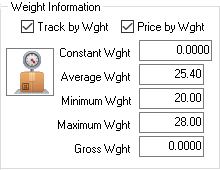Setting up Catchweight Items
Many entrée customers, especially those dealing with meat, poultry, and cheese, sell their products as catchweights (sometimes referred to as random weights, average weights, or variable weights). In this situation, the item may be physically packed in a case or a piece package but sold by the pound. However, each case or piece can have a different weight.
 One case of roast beef may weigh 35.5 lbs. whereas another may be 36.8 lbs.
One case of roast beef may weigh 35.5 lbs. whereas another may be 36.8 lbs.
Set up a catch weight item as you would any other with the exception of the following:
•It is recommended that the Track by Weight field is checked which allows for individual weights to be entered when the item is added to an invoice.
•The Price by Weight field must be checked.
•The Constant Weight field must be set to 0.
•The Average Weight field must not be 0.
•It is recommended that the Minimum and Maximum Weight fields are also defined.
•Both the costs and selling prices you define will be based on the price per pound.


•It is rarely done but if you only want to enter a lump sum or total weight for your item, you can uncheck the Track by Weight field.
•If System Option 26 and the Track by Weight options are enabled, users will be able to enter the individual catchweights. However, when the invoice prints, only the total weight will be shown. This has been provided for distributors that would like entrée to automatically add the individual weights, but don't want their customers to see them.
•If System Option 46 is not enabled, you will not be able to print an invoice until the weight information has been entered into the entrée system.
•If System Option 52 is enabled, users will be allowed to enter the total weight for the line item even with the Track by Weight field checked.
